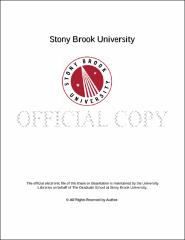| dc.identifier.uri | http://hdl.handle.net/11401/77517 | |
| dc.description.sponsorship | This work is sponsored by the Stony Brook University Graduate School in compliance with the requirements for completion of degree. | en_US |
| dc.format | Monograph | |
| dc.format.medium | Electronic Resource | en_US |
| dc.language.iso | en_US | |
| dc.publisher | The Graduate School, Stony Brook University: Stony Brook, NY. | |
| dc.type | Dissertation | |
| dcterms.abstract | The novel is digital, it was digital, and it will be digital. Most authors have written on word processors and most publishers have made books with some form of desktop publishing software since the early 1990s. The first novels for digital display were written and published in the late 1980s. From a literary perspective, the question is whether such digital-born literature translates into palpable changes in the novel form, why, and how. Previous theories of the meeting of digital technology and literature have all too often presented a predetermined fate for this pairing—an essentialist vision of literature, technology, or both. I begin by showing this process at work in the creation of Michael Joyce’s afternoon, a story (1987), the most well-known hypertext fiction. Joyce’s work is often understood as evidence that hypertext and digital technologies were inherently suited to experimental practice. I show, instead, that hypertext technology was initially reader and user friendly, and that the experimentalism of afternoon should be credited to Joyce’s literary goals. Print books also became digitally born in the 1990s, with all major American publishers shifting to digital typesetting (or desktop publishing). This largely unnoticed shift shows a technology developing according to the particular state of the publishing industry during this period, and the fading influence of high postmodern literary style. I show how three authors—Mark Z. Danielewski, Jennifer Egan, and Junot DÃaz—turn digital technology toward more narrative means during this period, augmenting textual meaning with an enhanced typographical paratext. Last, I look at a digital book within a book, the Primer from Neal Stephenson’s The Diamond Age or, A Young Lady’s Illustrated Primer (1995), to show how this digital book remediates the social and contextual aspects of the early British novel. The Primer shows how clearly digital fiction has been defined as highly experimental, and how this constricts how we think about digital fiction and what it can be. Digitizing the novel has not meant something stable or predefined, but is a moving target, shifting to account for context, public, and literary moment. | |
| dcterms.abstract | The novel is digital, it was digital, and it will be digital. Most authors have written on word processors and most publishers have made books with some form of desktop publishing software since the early 1990s. The first novels for digital display were written and published in the late 1980s. From a literary perspective, the question is whether such digital-born literature translates into palpable changes in the novel form, why, and how. Previous theories of the meeting of digital technology and literature have all too often presented a predetermined fate for this pairing—an essentialist vision of literature, technology, or both. I begin by showing this process at work in the creation of Michael Joyce’s afternoon, a story (1987), the most well-known hypertext fiction. Joyce’s work is often understood as evidence that hypertext and digital technologies were inherently suited to experimental practice. I show, instead, that hypertext technology was initially reader and user friendly, and that the experimentalism of afternoon should be credited to Joyce’s literary goals. Print books also became digitally born in the 1990s, with all major American publishers shifting to digital typesetting (or desktop publishing). This largely unnoticed shift shows a technology developing according to the particular state of the publishing industry during this period, and the fading influence of high postmodern literary style. I show how three authors—Mark Z. Danielewski, Jennifer Egan, and Junot Díaz—turn digital technology toward more narrative means during this period, augmenting textual meaning with an enhanced typographical paratext. Last, I look at a digital book within a book, the Primer from Neal Stephenson’s The Diamond Age or, A Young Lady’s Illustrated Primer (1995), to show how this digital book remediates the social and contextual aspects of the early British novel. The Primer shows how clearly digital fiction has been defined as highly experimental, and how this constricts how we think about digital fiction and what it can be. Digitizing the novel has not meant something stable or predefined, but is a moving target, shifting to account for context, public, and literary moment. | |
| dcterms.available | 2017-09-20T16:52:51Z | |
| dcterms.contributor | Olster, Stacey | en_US |
| dcterms.contributor | Newman, Andrew | en_US |
| dcterms.contributor | Graham, Jean E | en_US |
| dcterms.contributor | Wilkens, Matthew. | en_US |
| dcterms.creator | Reina, Bradley | |
| dcterms.dateAccepted | 2017-09-20T16:52:51Z | |
| dcterms.dateSubmitted | 2017-09-20T16:52:51Z | |
| dcterms.description | Department of English | en_US |
| dcterms.extent | 165 pg. | en_US |
| dcterms.format | Monograph | |
| dcterms.format | Application/PDF | en_US |
| dcterms.identifier | http://hdl.handle.net/11401/77517 | |
| dcterms.issued | 2016-12-01 | |
| dcterms.language | en_US | |
| dcterms.provenance | Made available in DSpace on 2017-09-20T16:52:51Z (GMT). No. of bitstreams: 1
Reina_grad.sunysb_0771E_12979.pdf: 9398592 bytes, checksum: 161c7703da21fda8802b12ab50d18c65 (MD5)
Previous issue date: 1 | en |
| dcterms.publisher | The Graduate School, Stony Brook University: Stony Brook, NY. | |
| dcterms.subject | American Novel, Contemporary literature, Desktop Publishing, ebooks, Hypertext, New media | |
| dcterms.subject | American literature -- Modern literature | |
| dcterms.title | Digitizing the Novel, 1987-2010 | |
| dcterms.type | Dissertation | |

